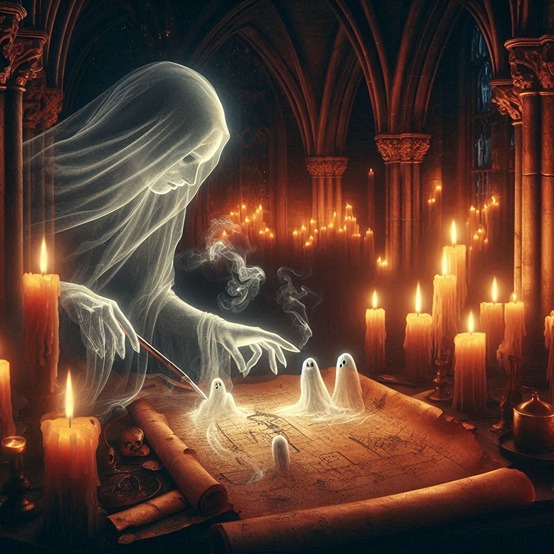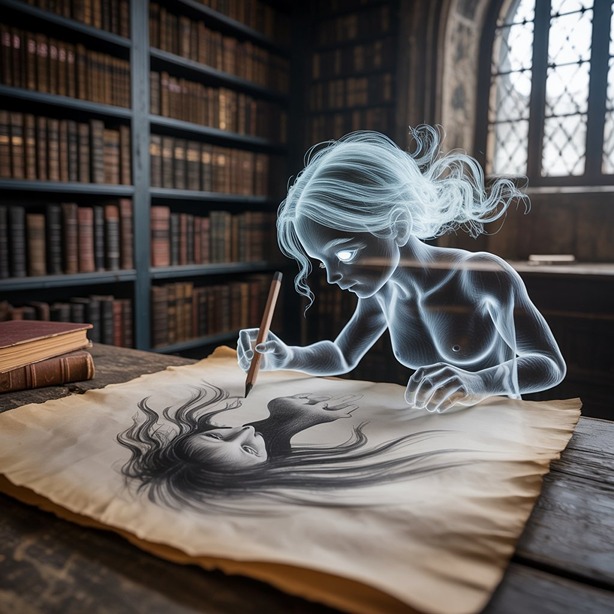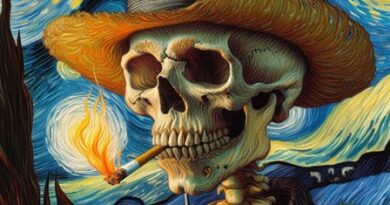A Living Art: How To Draw A Ghost That Actually Haunts?
“Daddy, I made you a drawing,” my eldest daughter announced a few days ago, with a proud smile, and handed me a colorful sheet of paper. One look at the figure that appeared there on the drawing, floating in the air, and I jumped on the spot as if I had seen a ghost. “What is this drawing?” I asked in a tone that was supposed to be authoritative, making sure that my wife – who always claims that I am not assertive enough with the girls and tries to make them love scary things – would hear and pay attention. “A ghost drawing, cute but a little scary,” my daughter explained innocently.
I had been waiting for this exact moment for years. For several minutes, I lectured my daughter about why ghosts are not real, and that she should watch content appropriate for her age, like “Dora the Explorer” and “PAW Patrol,” and not to what might blur the boundaries between reality and imagination, make her wonder about the precarious human existence in the face of endless death, and confuse her. “But Dad,” she replied, “you’re the one who likes scary things, and you started this horror website I am not allowed to visit. Besides, you always said that horror movies are the best thing in the world, and that romantic comedies, like the ones Mom likes to watch, are really stupid.” I don’t remember the rest, because the last thing I remember was wrapping myself in a blanket and flying away, while my wife was running after me with a fork.
Drawing ghosts is one of the most basic, yet beloved, tasks in the world of scary art. What makes ghost drawing so popular is that, on the one hand, it is effortless to draw, allowing even beginners to create their favorite ghost. On the other hand, it also provides potential for creativity with more complex twists and variations. Despite its relative simplicity, you can add layers of items, give the ghost different facial expressions, create transparency and glow effects, or even build “scenes,” perhaps explaining the circumstances of the ghost’s death and current whereabouts (it’s a shame that not enough horror movies have been made about this). So, how to draw a ghost, and why should you do it?
Why Drawing A Ghost Is A Great Idea?
It’s not hard to see why ghost drawings have become so popular, even among children. First and foremost, they’re quick and easy to draw. Unlike other scary characters that require a lot of detail or complex techniques – as you’ve seen in our tutorials on how to draw Chucky from the “Child’s Play” movies, drawing Freddy Krueger from the “Nightmare on Elm Street” franchise, or Jason Voorhees from the “Friday the 13th” movies – the basic version of a ghost consists of a few simple shapes that almost anyone can master. You can draw a relatively simple ghost by creating a circle for the head, a wavy body in a shape that somewhat resembles a sheet, and two black holes for the eyes. In a few minutes, or even seconds, you’ll have created your own ghost.
Another advantage of ghost drawings is the emotional range of the character, which can even express the painter’s perceptions of the world or their mood. The ghost can be both cute and charming, as seen in the drawing that opened this article, and also scary and threatening. Children will usually prefer to draw relatively friendly ghosts, characterized by broad smiles and large eyes. At the same time, adults or those more experienced will be able to create creepy versions, featuring detailed sunken eyes, a gaping mouth that appears to be screaming, and so on. All of this makes the ghost a character suitable for almost any age and skill level.

As we mentioned earlier, despite its basic simplicity, you can also find quite a bit of creative potential for ghost drawings. You can build realistic ghosts, add accessories to them, make them the protagonists or villains of a detailed scene, use different textures or unusual colors (who said that a ghost has to be in black and white?), and so on.
💀 Killer Deals & Scary Recommendations 💀
🎭 Costumes & Accessories
HalloweenCostumes Fun Costumes Entertainment Earth
🛒 Online Shopping
AliExpress Amazon Walmart Etsy
🧛 Collectibles & Horror Brands
Funko Hot Topic Lego Spirit Halloween
🎢 Attractions & Tours
GetYourGuide Tiqets Viator Klook
📖 Blogs & Horror Sites
Bloody Disgusting iHorror Fangoria
🩸 Disclaimer: Some links are affiliate links. The price stays the same – it just helps keep the site alive 👻
Starting From Scratch: How To Draw A Simple Ghost
The truth is that in the case of a drawing, one picture or video can be worth a thousand words. This is likely the case with drawing a ghost, which, in its simplest version, does not require a significant investment of time or skill. The starting point in most cases is the head, which can be shaped like an oval or a circle. Note that they do not have to be perfect. There are cases when irregularity adds interest to the drawing and character to the character. Besides, if the ghost were perfect, it would not actually be dead, would it?
In any case, the ghost’s body can be attached to the head or separate. The shape here is usually wavy, or even cloudy, sometimes like a sheet or swirling smoke. The face is also bare, with eyes that can be round, elliptical, or oval (two arcs of circles of different diameters). If you want a specific character, you can achieve it with the shape of the eyes and the distance between them. Close-set eyes, sometimes, look scarier.

As for the mouth, there are also some simple options to make. You can choose a simple circle, which may be expressionless or express a particular surprise. The mouth can be in a broad smile, indicating a “friendly” ghost, but also appear sad or angry.
It is up to you whether to add other details to the drawing, such as small hands and arms on the sides of the body. On the other hand, in most images of the ghost with which we are familiar, it is not tangible but rather ethereal, which means that a common choice is to create a ghost without limbs.
One of the advantages of drawing a ghost is that, in the elementary versions, you can easily make it without the need for sophisticated equipment. You can achieve the monochromatic shades of the ghost – usually white or black – with a white sheet of paper and a pencil. For gradation, you can use a black marker or felt-tip pen. To add color and interest, you can use a variety of tools, including colored pencils, markers, pastels, and even watercolors.
How To Draw A Simple Ghost? Here Are Some Helpful Tutorials
Countless websites on the Internet can show you how to draw a basic ghost and also take the drawing a few steps further. The starting point for many is, of course, YouTube, which shows videos that explain step by step how to build the work from scratch.
Here are some short tutorials, of a few seconds or at most minutes, showing how to draw a ghost step by step, and relatively easily:
👻 How to Draw a Simple Ghost – A recommended video of about three and a half minutes, from the Cartooning Club Junior channel, which explains (in English, with music) how to create a friendly and pretty basic version of the ghost.
👻 A video showing how to create a floating, and a little scary, ghost, from the very popular channel Art for Kids Hub (almost 10 million subscribers). What’s notable is that in the video, which lasts approximately six and a half minutes, you can see the father’s version (the guide) alongside the version that his child draws simultaneously.
The advantage is that detailed guides, such as those from Art for Kids Hub and Easy Drawing Guides, offer step-by-step instructions accompanied by clear pictures. They break down each step into simple geometric shapes, which makes it especially easy for children to understand the process. This way, they can also practice order and organization, movement planning, and other terms from the worlds of creativity and occupational therapy.
On the other hand, with simple drawings showing how to draw a ghost for kids, it is not at all necessary to have a guide explaining how to build the drawing step by step. You can rely on your imagination or recreate drawings that are available to you with a quick search on the Internet, for example, through Google, Pinterest, etc.
How To Draw A Scary Ghost?
Ready to move to the next level and create a ghost with more depth (sometimes literally) and character? It starts with facial expressions. Instead of simple round eyes, try half-moon-shaped eyes that can express cunning or malice. Try playing with the directions of the gaze, with eyes that look to the side instead of straight, which creates the impression of frenzy or mental instability. Of course, at this point, making the Mona Lisa effect – a situation where the figure looks directly at us wherever we are – will be too complex for you.
To add depth, you can use one of the following techniques:
👻 Creating layers with watercolors – A combination of water and paint can create partially transparent layers. If you let each layer dry before adding the next, you can get depth and a feeling that you can almost see through the ghost.
👻 Shadows and lighting – Add a small shadow under the ghost, to create a sense of levitation. You can incorporate relatively dark shades, such as gray, to add an effect of illumination or proximity to the light source.
👻 Blurred outlines – broken or blurred lines can create the effect that the ghost is not only in the air, but “disappears” into it.
👻 Glow – light shades in the center of the body, and dark at the edges, will create the effect of a halo, or even energy around the ghost.

Adding Details To The Drawing
A ghost doesn’t really have to be just a white sheet with eyes. You can draw it with historical clothing and accessories. Clothing that describes the character it was in life can provide background and even help you build a story: for example, a Gothic ghost in a Victorian dress, or the ghost of a knight still wearing his suit of armor.
To add cruelty to the drawing and hint at its life and the circumstances of its death, try incorporating chains, wounds, or blood stains on the clothes. The ghost can hold various accessories, such as a key, a lit candle, a magic book, and so on. Of course, it doesn’t really have to obey the laws of physics, but rather have unnaturally long and thin limbs, a head rotated 180 degrees as if she were Regan from “The Exorcist,” a body stretched and contorted in the style of “The Conjuring,” and so on. It all depends on your knowledge, imagination, and your mileage in horror movies.
The Background Does Matter
Continuing with the background of the painting, which can definitely take it into the realms of horror and raise its complexity by several levels. Here are some ideas that relate to the myth of ghosts:
👻 Haunted House – Try drawing a ghost hovering in a house or even an old mansion. You know, with peeling walls, old chandeliers, cobwebs, and a lot of mess.
👻 Cemetery – The ghosts’ current “home” can be the setting for your painting. Try incorporating tombstones, trees, and other figures, such as skeletons or skulls.
👻 Forest – another place with creepy potential, which also opens up a lot of doors for you in terms of design
👻 Children’s room – perhaps to indicate the children’s connection to the ghost myth
You can employ various techniques to characterize your background, such as using cold tones to create a threatening atmosphere, adding a sense of fog (achieved by gently rubbing the pencil on the paper), building contrast, or incorporating a sense of blurred elements in the drawing.
Creative Combinations And Ideas
What’s great about the world of horror is that there is literally no limit to its creativity, and this is also true in the case of ghost paintings. You can create animal ghosts, such as dogs, cats, and even dinosaurs. Or create a horror family composed of ghosts, or a ghost combined with another scary drawing, such as a demon, zombie, monster, or vampire.
The ghost can be colorful and have shapes that deviate from conventional ones. You get the idea: in paintings of this type, which depict an object that is uncertain whether it exists in real life, and we certainly do not know what it looks like, your imagination defines the painting.
Tutorials That Will Make Your Life Easier
In the case of complex ghost paintings, it is essential to find a guide who can explain the process of building the painting, typically step by step. In regular paintings, you can see an existing example and try to recreate it. Here, it is already essential to thoroughly understand the tools used, the techniques, the order of operations, and even the theoretical ideas. The encouraging news is that here too you can find guides to accompany you, even if their number, from our impression, is quite limited.
👻 A video from Art Hub Plus that shows, for about 12 minutes, how to draw a realistic ghost, and quite a complex one, actually. This ghost has some minor details and shading techniques. This specific version also includes alcohol-based markers (which offer advantages such as smooth blending of shades, impressive resistance to fading, and relatively fast drying). Still, you can apply most of this with more basic paints as well. In our opinion, this tutorial can also be suitable for relatively experienced children.
👻A detailed and quite elaborate “scene” of a ghost – Samara from “The Ring”, by the way – in a dark forest. The drawing is done using oil pastels, which, in my humble and unprofessional opinion, are comparable to the Panda Paints we buy. The drawing is more complex than what we’ve seen before, but still relatively simple, like most tutorials on the Art Easy for Beginners channel.
How Do You Get Better At Drawing Ghosts?
1. Regular practice: Like any skill, drawing gets better with practice. Try drawing a ghost occasionally, and gradually increase the complexity of the drawing. Observe how each attempt becomes increasingly easier.
2. Don’t be shy about learning – try watching videos or practicing techniques from artists. Not just painters, by the way, but also other visual artists who work on your imagination (for example, Tim Burton)
3. Sign up for a drawing course – you can sign up for a drawing course, physically or online, and thus experiment with different styles and complex works. You will get tools that can also upgrade your ability to create ghosts and other scary creatures
4. Try combining styles – you can try drawing a ghost in different styles, such as a realistic ghost, a cartoon, an anime, a pop style, and so on
5. Get feedback – If you want to improve the skill and quality of your drawings, don’t be shy about asking for input from others. Not only family members, but also groups on social media dedicated to art in general and paintings in particular
6. Documentation – Like any other painting, you can save your paintings, even those that are not masterpieces. Not only as a souvenir, but also to see your progress
Drawing a ghost is an excellent combination of simplicity and complexity, of cute and scary, of friendly and menacing. Whether you are a beginner taking your first steps in the world of painting (and even children) or an experienced artist looking for a new challenge, ghost painting offers a variety of creative possibilities. The simple basics offer a quick start and a sense of success, while the advanced options provide a long-term challenge.
Remember that there is no one “right” way to draw a ghost, since no one really saw a ghost and documented it. Every artist brings their own unique style, vision, and emotions to the work. Experiment, make mistakes, learn, and enjoy the process. Your first ghost awaits.





